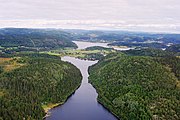|
Joint valley landscape Joint valley landscape or fissure valley terrain (Swedish: sprickdalslandskap, sprickdalsterräng) is a type of relief common in Fennoscandia. The landscape originates from the erosion of joints in the bedrock which leaves out small plateaus or ridges in between.[1] When the block summits in joint valley landscape are of different height it may indicate the past movement of a vertical geological fault.[1] Karna Lidmar-Bergström identified joint valley landscape areas centered on Blekinge, Bohuslän, Linköping/Västervik, Stockholm and Hudiksvall. In the last three areas the flat summits of the landscapes are parts of the Sub-Cambrian peneplain. In addition to this there is a large-scale joint valley landscape that extends from the High Coast inland.[2] The landscape type was first identified by Sten De Geer who in 1926 called it rutplatåland (lit. square plateau land).[3][4] Joint valley landscapes are among the few places in southern Sweden where there are steep slopes in excess of 25°.[5] Gallery
References
|

